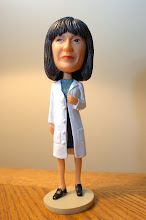 Ready for something sweet - of course I'm talking sugar, aka sucrose. Let's get into some detail about this most common of saccharides (disaccharide to be specific). It seems silly to ask what is so interesting about sugar, but I think it is interesting.
Ready for something sweet - of course I'm talking sugar, aka sucrose. Let's get into some detail about this most common of saccharides (disaccharide to be specific). It seems silly to ask what is so interesting about sugar, but I think it is interesting.We evolved (or if you prefer were created) needing to find calorie dense food and although food is now easily obtained and readily available, we haven't out grown that craving. The sense of sweetness was used to identify food that was ok to eat (there aren't any naturally occuring toxic substances with an apparant sweet taste, although there are plenty of man-made ones) and had higher calorie content.
I'm sure you all learned that we experience 4 taste sensations (I'll tell you about a 5th in a future post): sweet, salty, sour, and bitter. All products, sugar included, exhibit each of these tastes at some level. If you make a weak solution of sugar it will taste more sour than sweet. Sweeteners are are rated on their relative sweetness, so they can be compared, and the reference standard for the comparison is usually sugar (sucrose). Chemistry alert! All compounds that possess a sweet taste have a bipartate system capable of hydrogen bonding (with the taste receptors on our tongue) called a 'glycophore'. If you want to understand how that functions in the perception of sweetness click here. And if you are really hard core & want to know about the chemistry of taste recognition for all 4, try this.
So where does sugar come from? Sugarcane & sugar beets. The sucrose they yield is the same; there is no difference chemically, structurally or physically. We have 4 categories of sugar here in the U.S.: granulated, brown, liquid and specialty. Granulated is pretty self-explanatory; it is pure (99.8%) sucrose and comes in sizes ranging from large to powdered (coarse, sanding, extra fine, fruit, bakers special, 6X, 10X). Brown sugars are usually found as light or dark, but industrially we also have coated and free-flowing. Brown sugars are granular sugar that has been covered with cane syrup, which is why it is so sticky and gets so hard after being exposed to humidity & air. Liquid sugar is exactly what it sounds like, a solution of sucrose in water. It is used industrially and commercially, but it is unlikely that you will find it on a grocery shelf as it is not stable (microbially) for long periods of time. And specialty sugars, wow - there are quite a few: sugar cubes, fondant, invert, flavored, molasses, etc. Of these, molasses is probably the most interesting since everyone is familiar with it, but know very little about it. Molasses is the viscous liquid remaining at the end of processing when no more sugar can be crystallized from the product; this is known as 'blackstrap molasses'. New Orleans molasses is a by-product of open-kettle boiling, once the crystals have been centrifuged out, the remaining liquid is bottled.
Well my sweets, before I go into a sugar crash, I think it is time to close this post. I'll stay on saccharides next post, but will talk about some of its other forms. Bye!





1 comment:
I like sugar.
Post a Comment